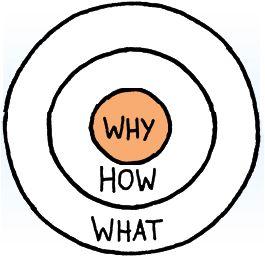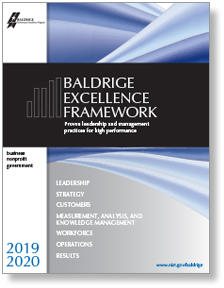Blogrige
The Official Baldrige Blog

I recently listened to a Ted talk by Simon Sinek, author of Start with Why: How Great Leaders Inspire Everyone to Take Action, and it caused me to reflect on some key questions in and related to the Baldrige Excellence Framework, as well as leadership in general.
Questions to Inspire
The Criteria within the Baldrige Excellence Framework are all about questions—questions to bring about insight, to promote new ways of thinking, to identify gaps in an organization’s performance, and to inspire excellence. Other series of questions can be used to encourage organizations to consider the Baldrige framework. For example, if you are asked by an organization’s senior leaders why they should consider the framework as a means of self-assessment or continuous improvement, you might ask the senior leaders a series of questions (heard from examiners and other Baldrige community leaders):
- Are you good?
- Are you getting better?
- How do you know?
Or
- What problem are you trying to solve?
- What opportunity are you trying to achieve?
- How are you going to measure that?
These sets of questions—and the Criteria questions themselves—can lead an organization to paint a fuller picture of their entire business model, from leadership to results, thereby helping them to identify strengths on which to capitalize and opportunities for improvement in which to invest resources.
But, when it comes to leadership, it’s the question “why” that is the most fundamental of all of the questions. According to the Baldrige framework,
Although the Criteria focus on key organizational performance results, these results by themselves offer little diagnostic value. For example, if some results are poor or are improving at rates slower than your competitors’ or comparable organizations’ results, you need to understand why this is so and what you might do to accelerate improvement.
The World’s Simplest Idea
In his book and Ted talk, Sinek puts forward what he calls “the world’s simplest idea,” and it all starts with “why.”
We follow those who lead not because we have to, but because we want to . . . and it’s those who start with “why” that have the ability to inspire those around them or find others who inspire them. . . . If you hire people just because they can do a job, they’ll work for your money, but if they believe what you believe, they’ll work for you with blood, sweat, and tears.

Sinek describes a golden circle with the word “why” in the very center and outer rings of “how” and “what.” In effective marketing materials, the most successful companies don’t start with what they provide or how they provide it, he said; they sell why you need their products.
“When we communicate from the inside out [looking at the circle with why in the center], we’re talking directly to the part of the brain that controls behavior, and then we allow people to rationalize it with the tangible things we say and do,” he said. “As it turns out, all the great and inspiring leaders and . . . inspired organizations—regardless of their size, regardless of their industry—all think, act, and communicate from the inside out.”
Sinek explains that people are inspired to buy something, work harder, take initiative, etc., because they believe not what the leader/organization is doing but why it is being done.
“People don’t buy what you do, they buy why you do it. . . . If you talk about what you believe, you will attract those who believe what you believe,” he said, citing Rev. Martin Luther King, Jr. attracting hundreds of thousands to his famous Lincoln Memorial speech not because he had a plan but because he had a dream. He also tells the story of the Wright brothers, credited with inventing the world's first successful motor-operated airplane, with no money, formal education, press, or market opportunity; what they had were supporters who believed what they believed.
Leading by helping others understand your “why” is a much better recipe for success than having money, the right people, and the right market conditions, he said.
Understand the Why
The Baldrige framework emphasizes transparency as defined by consistently candid and open communication, accountability, and the sharing of clear and accurate information by leadership and management. According to the framework, the goal is to help employees understand the “why” of what they are doing. Such understanding helps employees feel connected to the organization’s mission, vision, and values. In the case of many organizations—especially nonprofits, health care organizations, and education organizations—an employee’s connection to why the organization does what it does is a workforce driver; employees who believe in the values and what the organization believes in—both an emotional and intellectual connection—will feel more loyalty to that organization.
“Transparency is a key factor in workforce engagement and allows people to see why actions are being taken and how they can contribute. Transparency and accountability are also important in interactions with customers and other stakeholders, giving them a sense of involvement, engagement, and confidence in your organization,” according to the Baldrige framework.
In many, many workforce presentations of Baldrige Award winners, I’ve heard about these role-model organizations prioritizing hiring for a match with their cultures and values over skills—attracting people who believe in why the organization does what it does, with values that match the organization’s own values. Here are just a few Blogrige examples: “Building Employee Trust: Tips Validated by the Baldrige Excellence Framework,” “Baldrige is Answer to How to Create the Culture You Need,” “Leadership Practices of Integrated Project Management, Inc.”, “One Way to Carve Your Values—and Culture—in Stone,” and “How Values, Quarterly Coaching Address Clinician Burnout, Improve Engagement.”
Sinek’s view is in alignment with the Baldrige framework. He said the goal for organizations is to “hire people who believe what you believe” and “do business with the people who believe what you believe.” That is how you build loyalty and inspire others.
“If you do not know why you do what you do, and people respond to why you do what you do, then how will you ever get people to vote for you, or buy something from you, or, more importantly, be loyal and want to be a part of what it is that you do,” Sinek asked.
Starting with the why, Sinek says, explains why some organizations and some leaders are able to inspire where others are not. People won't truly buy into a product, service, movement, or idea until they understand the why behind it, he sums up.
Do you know why you do what you do? Do your employees understand their why?

Baldrige Excellence Framework
The Baldrige Excellence Framework has empowered organizations to accomplish their missions, improve results, and become more competitive. It includes the Criteria for Performance Excellence, core values and concepts, and guidelines for evaluating your processes and results.
Purchase your copy today!
Available versions: Business/Nonprofit, Education, and Health Care





